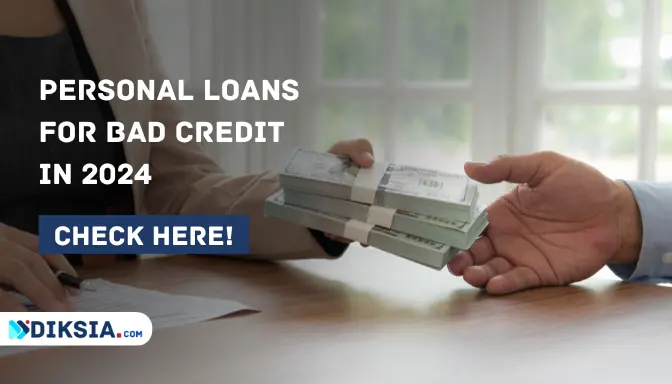Diksia.com - Having bad credit can make it hard to get a personal loan, but not impossible. There are lenders who specialize in offering loans to people with low credit scores, usually from 550 to 629. These lenders may charge higher interest rates and fees than other lenders, but they may also offer features that can help you improve your credit and finances, such as credit-building tools, flexible payments, and rate discounts.
If you need a personal loan and have bad credit, you should compare multiple offers from different lenders to find the best one for your situation. In this article, we will show you how to do that and what to look for before you apply.
What are personal loans for bad credit?
Personal loans for bad credit are loans that are designed for borrowers who have low credit scores or thin credit histories. These loans can be used for various purposes, such as debt consolidation, home improvement, medical expenses, or emergency costs.
Personal loans for bad credit typically have higher interest rates and fees than regular personal loans, because lenders consider them riskier. The average annual percentage rate (APR) for personal loans for bad credit is around 20%, compared to around 10% for regular personal loans, according to NerdWallet.
Personal loans for bad credit may also have shorter repayment terms, lower loan amounts, and stricter eligibility criteria than regular personal loans. For example, some lenders may require you to have a minimum income, a bank account, or a co-signer to qualify for a personal loan for bad credit.
How to compare the best personal loans for bad credit
To find the best personal loan for bad credit, you should compare multiple offers from different lenders and consider the following factors:
Interest rate
The interest rate is the percentage of the loan amount that you pay to the lender as the cost of borrowing. The lower the interest rate, the less you pay in interest over the life of the loan. However, the interest rate may not reflect the true cost of the loan, as it does not include other fees and charges that the lender may impose.
Therefore, you should also look at the APR, which is the total cost of the loan expressed as an annual percentage. The APR includes the interest rate and any other fees and charges that the lender may charge, such as origination fees, late fees, prepayment penalties, etc. The lower the APR, the better the deal for you.
Fees
Fees are additional charges that the lender may charge you for processing, servicing, or closing the loan. Some common fees that lenders may charge for personal loans for bad credit are origination fees, late fees, prepayment penalties, insufficient funds fees, etc.
Origination fees are usually a percentage of the loan amount that the lender deducts from the loan proceeds before disbursing them to you. Late fees are charged if you miss a payment or pay less than the minimum amount due. Prepayment penalties are charged if you pay off the loan early or make extra payments.
Insufficient funds fees are charged if your bank account does not have enough money to cover the loan payment. Fees can add up to the cost of the loan, so you should look for lenders who charge low or no fees for personal loans for bad credit.
Repayment term
The repayment term is the length of time that you have to pay back the loan. The repayment term can affect the monthly payment amount and the total interest cost of the loan. The longer the repayment term, the lower the monthly payment, but the higher the total interest cost.
The shorter the repayment term, the higher the monthly payment, but the lower the total interest cost. You should choose a repayment term that fits your budget and minimizes the interest cost of the loan.
However, you should also be aware that some lenders may charge prepayment penalties if you pay off the loan early or make extra payments, so you should check the loan agreement for any such clauses before you sign it.
Loan amount
The loan amount is the amount of money that you borrow from the lender. The loan amount can affect the interest rate, the fees, and the repayment term of the loan. The higher the loan amount, the higher the interest rate, the fees, and the monthly payment. The lower the loan amount, the lower the interest rate, the fees, and the monthly payment.
You should borrow only the amount that you need and can afford to repay, as borrowing more than you need or can afford can lead to debt problems and damage your credit further.
Credit score
Your credit score is a numerical representation of your creditworthiness, based on your credit history, credit usage, payment history, and other factors. Your credit score can affect your eligibility, interest rate, fees, and loan amount for personal loans for bad credit.
The higher your credit score, the more likely you are to qualify for a personal loan for bad credit, and the lower the interest rate, the fees, and the loan amount that you may get. The lower your credit score, the less likely you are to qualify for a personal loan for bad credit, and the higher the interest rate, the fees, and the loan amount that you may get.
You should check your credit score before you apply for a personal loan for bad credit, and try to improve it if possible, by paying your bills on time, keeping your credit utilization low, and disputing any errors on your credit report.
How to improve your chances of getting approved for a personal loan for bad credit
If you have bad credit, you may face some challenges when applying for a personal loan, such as getting rejected, getting unfavorable terms, or getting scammed by predatory lenders.
However, there are some ways that you can improve your chances of getting approved for a personal loan for bad credit, such as:
Applying with a co-signer
A co-signer is someone who agrees to repay the loan if you fail to do so. Having a co-signer with good credit can increase your chances of getting approved for a personal loan for bad credit, and getting a lower interest rate, lower fees, and higher loan amount.
However, you should be careful when choosing a co-signer, as they will be legally responsible for the loan, and their credit will be affected by your payment behavior. You should only ask someone who trusts you and is willing to take on the risk of co-signing for you, such as a family member or a close friend.
Using collateral or savings
Collateral is an asset that you pledge to the lender as security for the loan, such as your car, your home, or your savings account. Using collateral or savings can increase your chances of getting approved for a personal loan for bad credit, and getting a lower interest rate, lower fees, and higher loan amount.
However, you should be aware that if you default on the loan, the lender can seize your collateral or savings to recover the loan amount. You should only use collateral or savings that you can afford to lose, and that are worth more than the loan amount.
Shopping around
Shopping around means comparing multiple offers from different lenders before you apply for a personal loan for bad credit. Shopping around can help you find the best deal for your situation, and avoid getting scammed by predatory lenders who charge exorbitant interest rates and fees, or who have hidden terms and conditions.
You can use online platforms, such as Credible, NerdWallet, or Credit Karma, to compare the best personal loans for bad credit from various lenders, and see the rates, terms, and features that each lender offers.
You can also use online prequalification tools, which allow you to check your eligibility and potential rates without affecting your credit score, as they use a soft credit inquiry, which does not show up on your credit report.
Conclusion
Personal loans for bad credit are not impossible to get, but they may come with higher costs and risks than regular personal loans. Therefore, you should be careful when applying for a personal loan for bad credit, and compare multiple offers from different lenders to find the best one for your situation.
You should also look for ways to improve your credit score and finances, such as using credit-building tools, making timely payments, and saving money, so that you can qualify for better loan options in the future.






